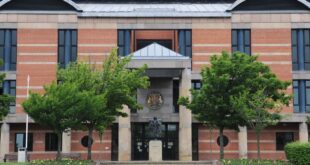A 17th Century diamond known as the Idol’s Eye and worth up to £21million is at the centre of a bitter High Court battle between warring members of the Qatari royal family
The multi-billionaire Al-Thani family are feuding over the 70.21 carat Mughal-era blue tinged diamond, formerly owned by an Ottoman sultan and – according to legend – kept as the eye of a secret idol in the Temple of Benghazi.
More recently to be found in the London home of the late Qatari culture minister, Sheikh Saoud bin Mohammed Ali Al-Thani, it is held in the name of a company owned by a foundation of which his widow and children are the beneficiaries.
But a cousin of the family – super-rich London-based art collector Sheikh Hamad bin Abdullah Al Thani, who has links to the British royal family and late Queen Elizabeth II – is now fighting a High Court tug-of-war over ownership of the gem.
Sheik al-Thani is a leading figure in British horse-racing and senior members of the Royal Family, including the King and the late Queen, have been guests at his £317million Mayfair mansion – reportedly Britain’s most expensive private home.
He claims that through his investment firm Qipco he has the right to buy the stone for $10million (£7.8m) after the Al-Thani family offered it for sale at the height of the Covid-19 pandemic in 2020.
But Elanus, the Al-Thani-linked company which currently owns the diamond, is fighting the case, claiming the family’s supposed offer to sell the gem was a ‘mistake.’
Lawyers say the firm itself had not wanted to sell it and that the alleged ‘offer’ was merely an expression of interest to sell by a single member of the Al-Thani family.
The 17th century Idol’s Eye diamond (pictured) is worth a staggering £21million and is at the heart of a bitter court feud between members of the Qatari royal family over who owns it

super-rich London-based art collector Sheikh Hamad bin Abdullah Al Thani (pictured outside London’s High Court) claims he has the right to buy the gem stone for £7.8million. But his family claim the stone is worth closer to £21m and that it was never up for sale

Sheikh Hamad bin Abdullah Al Thani reportedly has close ties to British royalty. He is seen her with the late Queen Elizabeth II in 2013
The late sheikh’s son, Sheikh Hamad bin Saoud Al-Thani, had been interested in selling it to fund property deals, but had not consulted his mother or siblings, while company directors had not even considered a sale, it is claimed.
And they say that the gem could be worth far more than the claimed sale price, with one expert putting its value at a staggering £21million.
The court heard the diamond – which is ‘colourless with a slightly bluish tinge’ – is thought to have been found in the Golconda mines in southern India in 1600.
‘It is said to have been owned by the 34th Ottoman Sultan, Abdul Hamid II, who allegedly kept it as the eye of a secret idol in the Temple of Benghazi,’ said Qipco barrister Robert Stewart KC.
Later, it was owned by high-end jeweller Harry Winston before later being bought by the late Sheikh Saoud for about £7million in 2004 and put into the name of a holding company, known as Elanus.
‘He kept it in his personal safe in his home in London,’ said Elanus barrister Sa’ad Hossain KC.
‘It was one of the most significant pieces in his collection, and one of the pieces he was most proud of.
‘It is also of particular personal importance to his wife, Sheikha Amna.’
The gem was put into the name of Elanus for inheritance planning reasons and then loaned to family cousin Sheikh Hamad bin Abdullah’s company Qipco in 2014 to be included in his Mughal collection at lavish exhibitions.

The Idol’s Eye diamond was previously found in the London home of the late Qatari culture minister, Sheikh Saoud bin Mohammed Ali Al-Thani (pictured) who died in 2014
Part of the loan agreement allowed for Qipco to purchase the diamond if Elanus made clear a ‘wish’ to sell.
The price would be based either on independent valuations gathered by the selling and buying parties, or US$10million (about £7.8m), whichever was higher.
Sheikh Saoud died in November 2014, leaving behind his widow, Sheikha Amna, daughters Sheikha Sara and Sheikha Moza, and son Sheikh Hamad bin Saoud.
Lawyers for Qipco say the process of sale of the diamond was put into train in February 2020 with a letter from Elanus’ Swiss solicitor.
Referencing the ‘loan agreement between Elanus and Qipco’, it stated: ‘I just learned from Sheikh Hamad, the son of the late Sheikh Saoud Al Thani, that the family would like to sell the Idol’s Eye.’
Qipco says it then began the purchasing process, but that the Al-Thani family went back on the offer, which they were not entitled to do under the terms of the loan agreement.
It is suing to enforce the sale at a price of US$ 10million, but Elanus’ lawyers say the letter taken as an offer to sell was a ‘mistake’ and could not be taken as stating the company’s ‘wish’ to get rid of the diamond.
It had been sent after the late sheikh’s son began considering the possibility of a sale to fund property deals, said Mr Hossain KC.

Sheikh Hamad bin Abdullah is pictured outside London’s High Court after a hearing about who owns the Idol’s Eye diamond
‘Although the February 6 letter said that the family wished to sell the Idol’s Eye, they did not,’ the barrister told Judge Simon Birt KC.
‘Indeed, they had not even discussed or considered it.
‘As for Elanus and its ultimate beneficial owner, the Foundation, they had not even been consulted, let alone formed any “wish”.
‘Even Sheikh Hamad bin Saoud, who set in motion getting advice on pre-emption and the drafting of the letter, had only sought to explore the possibility of a sale at the right price.
‘When the rest of the family learned of the letter, they were understandably shocked, and corrected the position to Qipco – well before Qipco served any purchase notice.
‘It is Qipco’s flat refusal to accept that withdrawal, and instead to insist on completing the purchase without Elanus’s consent, that has also led to this dispute.’
He said the letter which triggered Qipco’s claim of a right to buy was ‘fundamentally incorrect’ because the family as a whole had not been consulted.
‘As such, the suggestion in the letter that “the family would like to sell the Idol’s Eye” was completely wrong: the family had not even considered the matter,’ he argued.
Additionally, the diamond is owned by the company Elanus and not the Al-Thani family and the letter could not be construed as an offer from the company, he added.
‘The directors of Elanus did not pass any resolution, or decide, that they wished to sell the Idol’s Eye,’ he told the judge.
‘The directors had no involvement whatsoever in the events alleged to constitute the ‘wish’ by the February 6 letter.’

Sheikh Hamad bin Abdullah is one of Britain’s most wealthy people. His £317million Mayfair mansion Dudley House (pictured) is reportedly Britain’s most expensive private home
But for the cousin’s Qipco company, Mr Stewart said it was his case that the February 6 letter constituted a ‘wish to sell’ or for Qipco to return the diamond under the loan agreement.
He said Elanus’ claim to be a distinct entity from the Al-Thani family was ‘crumbling,’ since the company’s defence had been ‘determined by the family,’ which is funding its case and whose interests are being pursued.
‘The family are Sheikh Saoud’s heirs,’ he told the judge. ‘They are central to this case because the February letter was expressed as a communication of their wishes on behalf of Elanus.’
He said that Elanus had in February and March 2020 become ‘fixed with the wish to sell’ and that the family and the Foundation behind the company ‘acted at this time as Elanus’ directing mind and will for all such decisions.’
The Swiss lawyer had ‘clear’ authority to send the letter following ‘unambiguous instruction’ to write ‘a formal letter as the representative of Elanus informing Qipco that we wish to sell the Idol’s Eye,’ he continued.
‘Sheikh Hamad bin Saoud’s clear priority at the time was to enforce a sale as soon as possible,’ he said.
That triggered Qipco’s right to buy, he told the judge.
‘Qipco’s position is that it is entitled to an order that Elanus sell it the asset for a price of US$10 million,’ he continued.
‘It reaches this figure on the basis that, Elanus not having provided any auction mid-estimate, the only available valuations, the Christie’s valuations, are for US$ 7-10 million.
‘Accordingly, there is no basis for applying a price above the contractually agreed minimum price of US$ 10million.’
The hearing continues.
Source link



